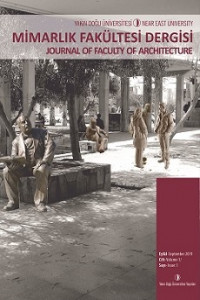Abstract
Tarih boyunca kentler, çeşitli araştırmacılar tarafından, kültür ve medeniyetlerin doğduğu, geliştiği ve yayıldığı yerler olarak tanımlanmışlardır. Kentler ilk ortaya çıktıkları tarihten günümüze büyük değişimler geçiren kentler, tarihsel süreç içinde site, polis, komün ve kent devletleri gibi adlar alırken yaşantının dönüşmesi özellikle endüstri devrimi sonrası yaşanan büyük değişimlerle biçimsel ve işlevsel değişimler geçirmişlerdir. Avrupa ve Amerika kentlerinde yaşanan hızlı değişim, ortaçağ kent dokularının periferisinde yeni kent çekirdekleri oluşturmuş ya da yeni toplumsal ekonomik ilişkilerle şekillenen yeni endüstri kentleri kurulmuştur. KKTC Lefkoşa kenti, endüstrileşme sürecini Avrupa ve Amerika‟daki kentlere koşut hızla yaşamadığından kentin ortaçağ yapılanması ve fiziksel bütünlüğü bozulmadan günümüze ulaşmıştır. Bu çalışmanın amacı, 13. yy kent dokusu özelliklerini kaybetmeden günümüze ulaşabilmiş ender yerleşmelerden biri olan Lefkoşa‟nın İ.Ö. 280 yılında Mısır Kralı Ptoleme Soter‟in oğlu Leucus tarafından inşa edilen Lefkotheon adı verilen kentin kurulduğu tarihten başlayarak , 13. yy daki biçimini almasına dek geçirdiği süreci incelemek ve Ortaçağ kent yapıları içerisindeki yerini kent tarihi açısından belirlemektir
Keywords
References
- Atun, Ata (2006). „Milat Öncesinden Günümüze Kıbrı Tarihi Üzerine Belgeler (Cilt2)‟, Samtay Vakfı Yayınları:15, Mağusa.
- Bergil, M. Suat (2006). „Doğu Akdeniz‟de Bir Uygarlık Gemisi‟, Galeri Kültür Yayınları (Repa Ltd), Lefkoşa.
- Cobham, Claude Delval (1908). Excerpta Cypria; Materials for a History of Cyprus. Cambridge: University Press.
- Erçin, Çilen (2013). Tarihsel Süreç İçinde Kent Fiziki Tasarımının İrdelenmesi, Lefkoşa Kent Örneği. Doktora tezi, Lefkoşa. Gazioğlu, Ahmet C. (1990). The Turkish in Cyprus: A Province of the Ottoman Empire (1571-1878), London.
- Gazioğlu, Ahmet C. (2001). „Kıbrıs Türk Tarihi – Türk Dönemi (1570-1878)‟, Lefkoşa: Kıbrıs Araştırma Ve Yayın Merkezi CYREP.
- Gürkan Muzaffer (1996). „Dünkü Ve Bügünkü Lefkoşa‟, Galeri Kültür Yayınları (Repa Ltd), Lefkoşa.
- Gürkan, Haşmet Muzaffer (2006). „Kıbrıs Tarihinden Sayfalar‟, Galeri Kültür Yayınları (Repa Ltd), Lefkoşa.
- Gürkan, Haşmet Muzaffer (2000). „Tarih İçinde Kıbrıs‟, Galeri Kültür Yayınları (Repa Ltd), Lefkoşa.
- Keshishan Kevork K. (1974). Nicosia Capital of Cyprus Then And Now. Nicosia: First published within Swissair International Calender.
- Lynch, K (1989). Good City Form, London: MIT Press.
- Mariti, Giovanni (1909). Travels In The Island of Cyprus. Cambridge: Translation by C.D.Cobham.
- Navari, Leonar (2003). Maps of CyprusFrom the collections of the bank of Cyprus Cultural Foundation, Nicosia.
- Newman, Philip (1948). A Guide to Cyprus with Maps, Illustration and Photographs, Nicosia: Rustem Yayınevi.
- Newman, Philip (1985). A Short History of Cyprus. Nicosia: Zavallis Press Ltd.
Abstract
Throughout the history, cities have been described by various researchers as the places where culture and civilizations were born, developed and spread. Cities have undergone major changes since they first emerged and throughout the history as they took the names such as sites, police, communes and city states, the transformation of life has undergone formal and functional changes especially after the industrial revolution. The rapid changes in European and American cities had created new urban cores in the periphery of the medieval urban fabric or new industrial cities shaped by new social economic relations. Since the city of Nicosia in TRNC have not experienced the industrialization process in parallel with the cities in Europe and America, the city‟s medieval structure and physical integrity has survived to the present day. The aim of this study is to investigate the history of the city of Nicosia, which is one of the rare settlements that survived to the present day without losing its 13th century urban texture. Nicosia city, which was named as Lefkotheon, was built by the Egyptian King Ptoleme Soter's son, Leucus. The study also aims to examine the process of Lefkotheon city from the date it was established until it took its form in the 13th century, and to determine its place in medieval city structures in terms of urban history
Keywords
References
- Atun, Ata (2006). „Milat Öncesinden Günümüze Kıbrı Tarihi Üzerine Belgeler (Cilt2)‟, Samtay Vakfı Yayınları:15, Mağusa.
- Bergil, M. Suat (2006). „Doğu Akdeniz‟de Bir Uygarlık Gemisi‟, Galeri Kültür Yayınları (Repa Ltd), Lefkoşa.
- Cobham, Claude Delval (1908). Excerpta Cypria; Materials for a History of Cyprus. Cambridge: University Press.
- Erçin, Çilen (2013). Tarihsel Süreç İçinde Kent Fiziki Tasarımının İrdelenmesi, Lefkoşa Kent Örneği. Doktora tezi, Lefkoşa. Gazioğlu, Ahmet C. (1990). The Turkish in Cyprus: A Province of the Ottoman Empire (1571-1878), London.
- Gazioğlu, Ahmet C. (2001). „Kıbrıs Türk Tarihi – Türk Dönemi (1570-1878)‟, Lefkoşa: Kıbrıs Araştırma Ve Yayın Merkezi CYREP.
- Gürkan Muzaffer (1996). „Dünkü Ve Bügünkü Lefkoşa‟, Galeri Kültür Yayınları (Repa Ltd), Lefkoşa.
- Gürkan, Haşmet Muzaffer (2006). „Kıbrıs Tarihinden Sayfalar‟, Galeri Kültür Yayınları (Repa Ltd), Lefkoşa.
- Gürkan, Haşmet Muzaffer (2000). „Tarih İçinde Kıbrıs‟, Galeri Kültür Yayınları (Repa Ltd), Lefkoşa.
- Keshishan Kevork K. (1974). Nicosia Capital of Cyprus Then And Now. Nicosia: First published within Swissair International Calender.
- Lynch, K (1989). Good City Form, London: MIT Press.
- Mariti, Giovanni (1909). Travels In The Island of Cyprus. Cambridge: Translation by C.D.Cobham.
- Navari, Leonar (2003). Maps of CyprusFrom the collections of the bank of Cyprus Cultural Foundation, Nicosia.
- Newman, Philip (1948). A Guide to Cyprus with Maps, Illustration and Photographs, Nicosia: Rustem Yayınevi.
- Newman, Philip (1985). A Short History of Cyprus. Nicosia: Zavallis Press Ltd.
Details
| Primary Language | Turkish |
|---|---|
| Journal Section | Research Article |
| Authors | |
| Publication Date | September 16, 2019 |
| Published in Issue | Year 2019 Volume: 1 Issue: 1 |
Cite
All Rights Reserved - Near East University JOURNAL OF FACULTY OF ARCHITECTURE (JFA) is an Open Access journal, under Licensed CC-BY-NC.


